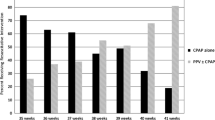Abstract
Objective:
Long-distance air transport (LDAT) of infants with pneumoperitoneum for pediatric surgical evaluation has not been previously reported. We examined whether extremely low birth weight (ELBW) infants with and without pneumoperitoneum would tolerate transport differently.
Study Design:
A retrospective cohort study was conducted comparing ELBW infants diagnosed with pneumoperitoneum to other ELBW infants transported >2000 miles by a trained team from a US Department of Defense tertiary care neonatal intensive care unit in Okinawa, Japan.
Result:
Between 2000 and 2006, 49 air transports met study criteria. Seven of the 49 (14%) infants had pneumoperitoneum at time of transport. The average distance flown was 5346 miles per transport. The 49 infants had a median gestational age of 25 weeks and birth weight of 761±127 g. ELBW infants without pneumoperitoneum were transported at a median 58 days of life (DOL; range 30 to 91 days) compared to infants with pneumoperitoneum, who were transported at a median 8 DOL (range 6 to 14 days). At the time of LDAT, infants with pneumoperitoneum were significantly smaller, receiving more arterial and central venous access, more pressors for hypotension, and more mechanical ventilation compared to ELBW infants transported without pneumoperitoneum. In-flight patient-related medical issues were similar regardless of underlying diagnosis or age at the time of transport.
Conclusion:
Successful LDAT of ELBW infants, including critically ill infants with intestinal perforation, is possible. Use of personnel, experienced and trained in aviation transport physiology, overcomes the extreme physiologic operating environment associated with LDATs.
This is a preview of subscription content, access via your institution
Access options
Subscribe to this journal
Receive 12 print issues and online access
$259.00 per year
only $21.58 per issue
Buy this article
- Purchase on Springer Link
- Instant access to full article PDF
Prices may be subject to local taxes which are calculated during checkout
Similar content being viewed by others
References
Section on Transport Medicine, American Academy of Pediatrics. ‘Transport physiology and stresses of transport’, In: Woodward GA, Insoft RM, Kleinman ME (eds). Guidelines for Air and Ground Transport of Neonatal and Pediatric Patients, 3rd edn. American Academy of Pediatrics: Elk Grove, 2007, pp 197–217.
Samuels MP . The effects of flight and altitude. Arch Dis Child 2004; 89: 448–455.
Attridge JT, Clark R, Walker MW, Gordon PV . New insights into spontaneous intestinal perforation using a national data set: (1) SIP is associated with early indomethacin exposure. J Perinatol 2006; 26: 93–99.
Gordon PV, Swanson JR, Attridge JT, Clark R . Emerging trends in acquired neonatal intestinal disease: is it time to abandon Bell's criteria? J Perinatol 2007; 27: 661–671.
Blakely ML, Lally KP, McDonald S, Brown RL, Barnhart DC, Ricketts RR . Post operative outcomes of extremely low birth-weight infants with necrotizing enterocolitis or isolated intestinal perforation: a prospective cohort study by the NICHD neonatal research network. Ann Surg 2005; 241: 984–994.
Moss RL, Dimmitt RA, Henry MCW, Geraghty N, Efron B . A meta-analysis of peritonealdrainage versuslaparotomy for perforated necrotizing enterocolitis. J Pediatr Surg 2001; 3: 1210–1213.
Blakely ML, Tyson JE, Lally KP, McDonald S, Stoll BJ, Stevenson DK, et al., NICHD Neonatal Research Network. Laparotomy versus peritoneal drainage for necrotizing enterocolitis or isolated intestinal perforation in extremely low birth weight infants: outcomes through 18 months adjusted age. Pediatrics 2006; 117: e680–e687.
Grosfeld JL . Peptic ulcer and other conditions of the stomach. In: Grosfeld JL, O’Neill JA, Coran AG, Fonkalsrud EW (eds). Pediatric Surgery. Mosby: Philadelphia, 2006, pp 1225–1241.
Harbinson SP . Intubation of the stomach and small intestines. In: Yeo CJ, Dempsey DT, Klein AS, Pemberton JH, Peters JH (eds). Shackelford's Surgery of the Alimentary Tract. Saunders: Philadelphia, 2006, pp 749–753.
Acknowledgements
We thank the US Air Force NICU nurses and technicians, the aeromedical evacuation teams, flight-deck crew, aircraft maintenance and ground crew members, and the Theater Patient Movement Requirements Center for their hard work and dedication. They are essential for making our neonatal air transports safe and successful.
Author information
Authors and Affiliations
Corresponding author
Additional information
Disclosure
The opinions expressed in this paper are solely those of the authors and do not represent the views of the US Air Force, US Navy, Department of Defense or the US Government.
Rights and permissions
About this article
Cite this article
McAdams, R., Dotzler, S., Pole, G. et al. Long-distance air medical transport of extremely low birth weight infants with pneumoperitoneum. J Perinatol 28, 330–334 (2008). https://doi.org/10.1038/jp.2008.7
Received:
Revised:
Accepted:
Published:
Issue Date:
DOI: https://doi.org/10.1038/jp.2008.7


